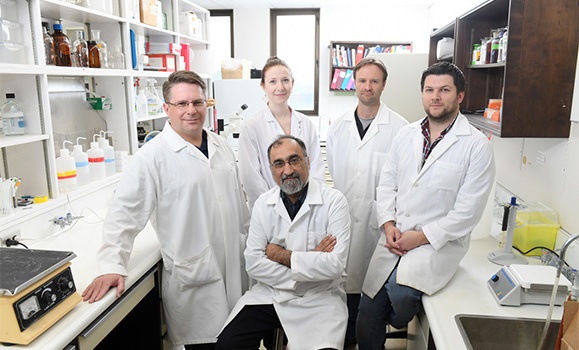A Halifax-based research team has received close to $1.5 million from the Canadian Institutes of Health Research (CIHR) that will help with the development an earlier, more definitive way of diagnosing Alzheimerās disease.
The grant was awarded to lead applicant Dr. Sultan Darvesh (pilipiliĀž»), together with co-applicants Dr. Ian Pottie (Mount Saint Vincent University) and Dr. Steve Burrell (pilipiliĀž» and the Nova Scotia Health Authority), and several additional collaborators.
In February of 2016, revealed that, through extensive collaboration and determination, the team had developed a new type of diagnostic agent that willĀ hopefully advance the fight against Alzheimerās disease through early detection (involving non-invasive diagnostic scanning) and, ultimately, new treatments.
Alzheimerās disease, the most common form of dementia, affects millions of people worldwide. A major obstacle in treating the disease is not having an accurate early diagnosis.
Moving towards better treatment
The key to this new development is a small radioactive molecule (āradiotracerā), synthesized to bind to an enzyme associated with the pathological structures in brains affected by Alzheimerās disease.Ā The group has demonstrated that this radiotracer can be used in brain imaging to distinguish between ānormalā brains and those affected by Alzheimerās disease ā a development process that has taken 11 years.
, the team has confirmed the targeted enzyme is uniquely associated with pathology in the Alzheimerās affected brain and a radiotracer targeting this enzyme can distinguish between Alzheimerās and normal brains using pre-clinical brain imaging.Ā The next step is refining the compound with an aim of starting clinical trials in about five years. This latest funding from CIHR will help move that process forward.
āWe now need to take what weāve learned so far and get ready to submit for approval of an experimental new drug for human imaging,ā says Dr. Darvesh. Ā
The work to refine the compound will begin in a lab at the Mount under Dr. Pottieās leadership.
āThe Mount lab is home to the synthesis, characterization and biochemical investigations of this puzzle,ā explained Dr. Pottie.
The compounds will then be put to the test at pilipiliĀž».
The importance of clinical trials
According to Drs. Darvesh and Pottie, the compound in its current form has both good and bad qualities.
āIn order to head to clinical trials, we need to reduce the bad without affecting the good,ā Dr. Darvesh says.
That will include reducing side effects, ensuring molecules cannot be metabolized by the blood (i.e. increasing bioavailability) and increasing the compoundās effectiveness in passing through the blood-brain barrier (i.e. getting it pilipiliĀž»fully into the brain).
Additional funding will be needed in the next five years in order to propel this work closer to the development finish line and into clinical trials. The team continues to seek agency funding and other donations to help in taking this major breakthrough from lab to bedside.
Other supporters
In addition to the support of CIHR, this work has been funded by the Department and Faculty of Medicine, pilipiliĀž»; Mount Saint Vincent University; Dalhousie Medical Research Foundation; Sobey Foundation through the Dalhousie Medical Research Foundation Irene Macdonald Sobey Chair in Curative Approaches to Alzheimer's Disease; Natural Sciences and Engineering Research Council of Canada; Nova Scotia Health Research Foundation; Brain Repair Centre; Innovacorp; Treventis Corporation; and The Maritime Brain Tissue Bank.

